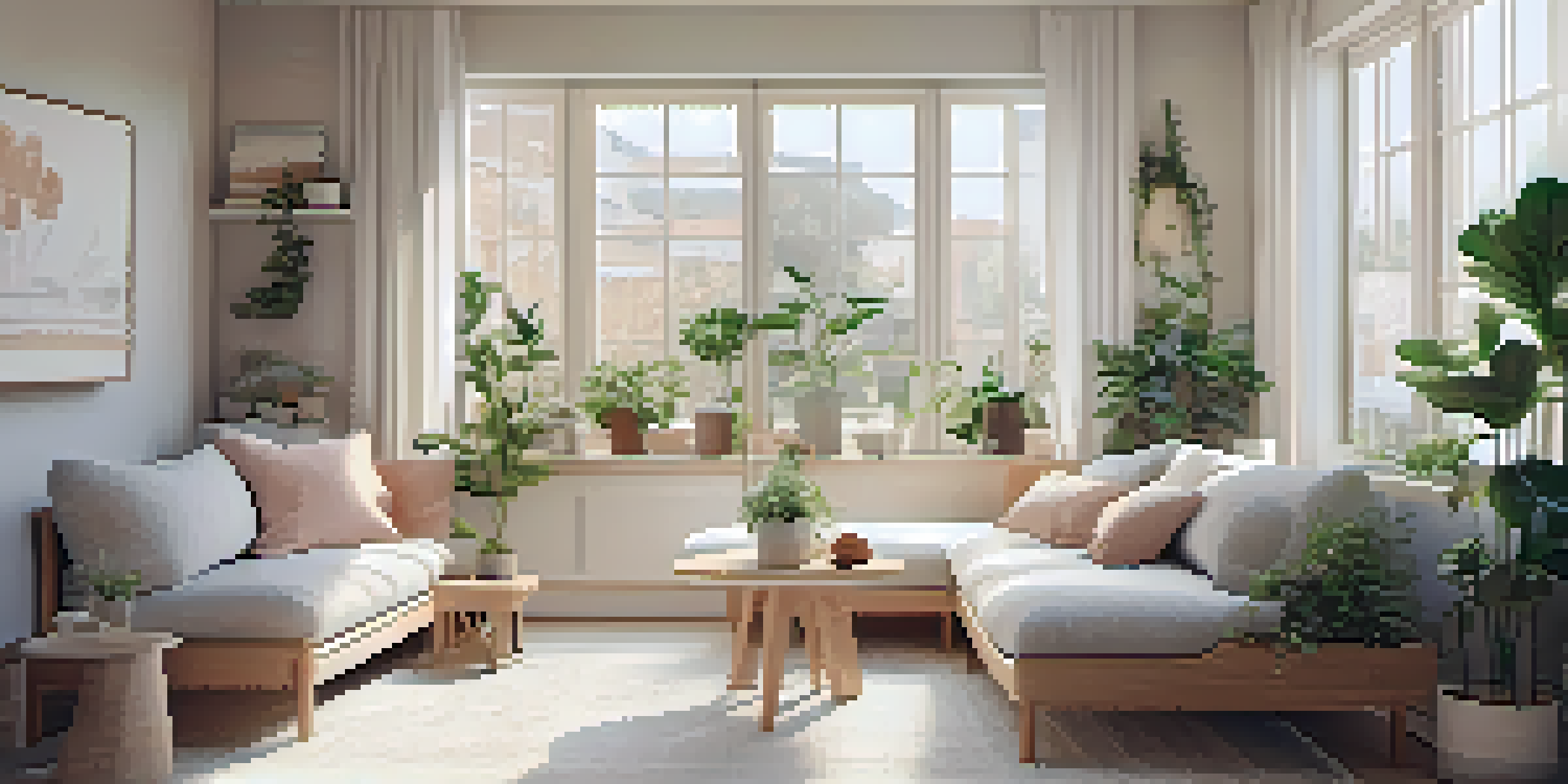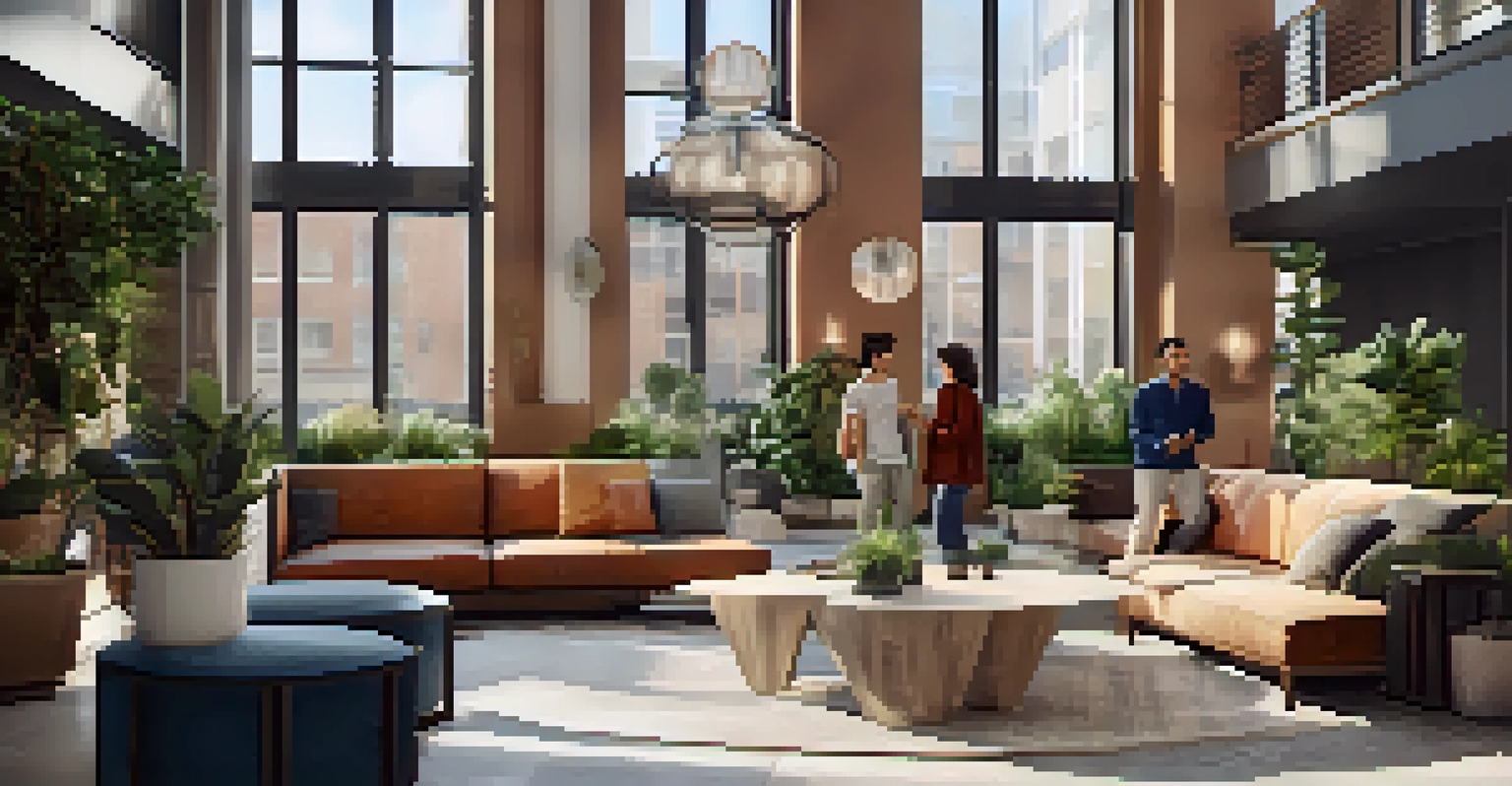Home Design for Urban Spaces: Future Considerations

Embracing Flexibility in Small Urban Homes
In urban areas where space is at a premium, flexibility in home design is essential. Multi-functional furniture, like foldable tables and Murphy beds, transforms small spaces into versatile living areas. This adaptability allows residents to customize their environments for both work and leisure, meeting the demands of modern urban life.
Sustainability is not a destination, it's a journey.
Moreover, the concept of flexible spaces is not just about furniture; it's about the layout too. Open floor plans can create a sense of spaciousness and fluidity, making it easier to transition from one activity to another. This approach encourages creativity in how we use our homes, fostering an environment that can change with our needs.
As we look to the future, innovative design solutions like modular walls and movable partitions are gaining popularity. These features empower homeowners to reconfigure their spaces quickly, ensuring that their homes can grow and adapt alongside their lifestyles.
Sustainability: A Key Element of Urban Design
Sustainable design is becoming a cornerstone of urban home design, reflecting a growing awareness of environmental impact. Green building materials, energy-efficient appliances, and smart home technologies are all pivotal in creating eco-friendly living spaces. Not only do these features reduce carbon footprints, but they also promote a healthier lifestyle for residents.

Incorporating nature into urban design is another exciting trend. Rooftop gardens, vertical green walls, and community green spaces offer a slice of nature in concrete jungles. These elements not only improve air quality but also enhance mental well-being, providing a comforting escape from the bustling city outside.
Flexibility in Urban Home Design
Multi-functional furniture and adaptable layouts enhance small urban living spaces, allowing residents to tailor their environments.
Looking forward, urban planners and designers will likely focus more on integrating sustainable practices into every aspect of home design. This shift not only meets the demands of environmentally conscious consumers but also paves the way for a healthier planet.
Smart Home Technology: The Future of Urban Living
Smart home technology is revolutionizing how we interact with our living spaces, especially in urban environments. From voice-activated assistants to smart thermostats, these innovations not only enhance convenience but also improve energy efficiency. Imagine controlling your home’s lighting and temperature from your smartphone, all while reducing your energy bills.
Design is not just what it looks like and feels like. Design is how it works.
Moreover, smart technology can aid in security, providing peace of mind for urban dwellers. With smart locks and surveillance cameras, homeowners can monitor their properties in real-time, whether they are at home or away. This added layer of security is becoming increasingly important in densely populated areas.
As technology continues to evolve, the integration of AI and machine learning into home systems will further personalize urban living. The homes of the future may anticipate our needs, creating tailored experiences that enhance our daily routines.
Urban Gardens: Bringing Nature Back Home
Urban gardening is gaining traction as a way to reconnect city dwellers with nature. Whether through balcony gardens or community plots, these green spaces provide not only fresh produce but also a sense of community. Gardening can be a therapeutic escape from the fast pace of city life, promoting mental well-being.
Additionally, urban gardens play a vital role in sustainability efforts by improving air quality and reducing urban heat. They can be designed in various forms, from vertical gardens to hydroponic systems, making them suitable for even the smallest of spaces. This versatility allows residents to cultivate their green thumb, regardless of their living situation.
Sustainability Shapes Urban Living
Eco-friendly materials, green spaces, and smart technologies are becoming integral to urban home design, promoting healthier lifestyles.
In the future, we may see more innovative solutions for integrating gardens into urban architecture, such as green roofs and edible landscapes. These developments not only beautify urban spaces but also contribute to a healthier, more sustainable urban ecosystem.
Designing for Community: Shared Spaces in Urban Homes
As urban populations grow, the importance of community-centered design becomes increasingly evident. Shared spaces, such as communal lounges and co-working areas, foster social interactions among residents, creating a sense of belonging. These spaces encourage collaboration and connection, which can be especially valuable in bustling cities.
Moreover, shared amenities can enhance the living experience without requiring individual investments. For instance, a shared gym or rooftop terrace allows residents to enjoy facilities that might be impractical in their own homes. This model not only maximizes space but also cultivates a spirit of cooperation among neighbors.
Looking ahead, urban home designs will likely prioritize these shared spaces, recognizing their role in building resilient communities. As people increasingly seek connection in urban settings, designing for interaction will become a fundamental aspect of home planning.
The Role of Aesthetics in Urban Home Design
Aesthetics play a crucial role in urban home design, influencing how residents feel in their spaces. Thoughtful design choices, from color palettes to furniture styles, can enhance the ambiance and functionality of a home. Creating a visually pleasing environment not only boosts mood but also reflects the personality and values of the inhabitants.
In urban settings, where homes can often feel cramped, aesthetics can make a significant difference. Strategic use of mirrors, lighting, and decor can create an illusion of space and brightness, transforming even the smallest apartments into inviting havens. This focus on aesthetics encourages homeowners to take pride in their living spaces.
Community-Centered Shared Spaces
Designing shared spaces within urban homes fosters social connections and enhances the living experience for residents.
As trends evolve, we expect to see a blend of styles that celebrate individuality while remaining practical. The future of urban design will likely embrace a mix of modern and traditional elements, allowing residents to curate spaces that resonate with their unique identities.
Future Trends: The Evolution of Urban Living Spaces
The evolution of urban living spaces is a dynamic process shaped by cultural shifts and technological advancements. As remote work becomes more normalized, the demand for designated home offices and flexible workspaces is on the rise. This trend is reshaping how we design our homes, prioritizing functionality alongside comfort.
Additionally, the concept of ‘15-minute cities’ is gaining traction, emphasizing the importance of accessibility and convenience. Homes designed within walking distance of essential services—like grocery stores, parks, and schools—will become increasingly desirable. This focus on urban planning aligns with the desire for a simpler, more connected lifestyle.

Looking toward the future, urban design will continue to adapt to the changing needs and preferences of residents. By embracing innovation and sustainability, we can create urban spaces that not only meet contemporary demands but also inspire future generations.